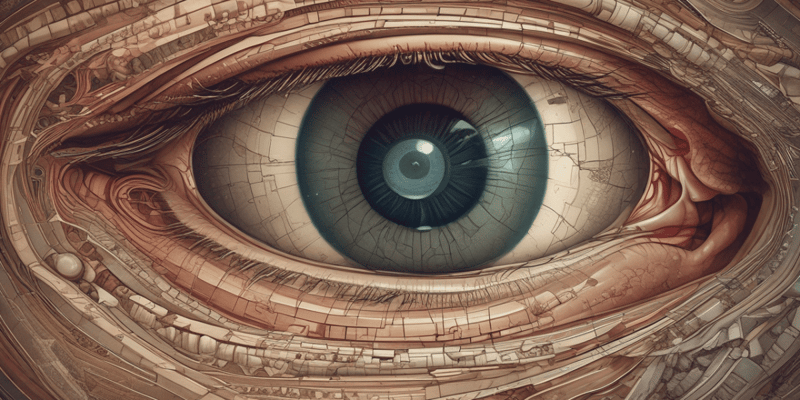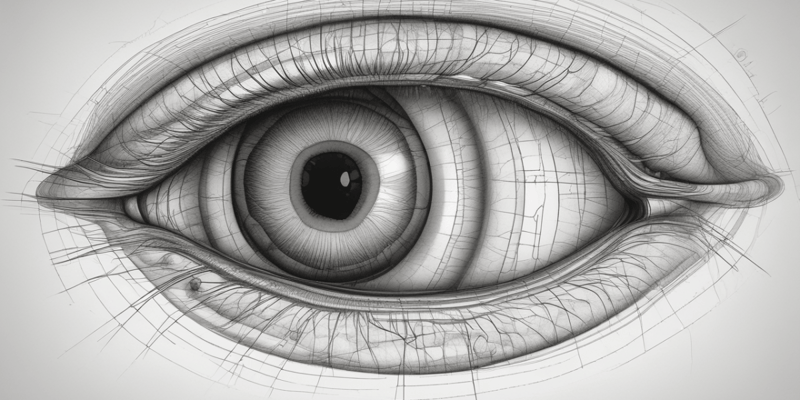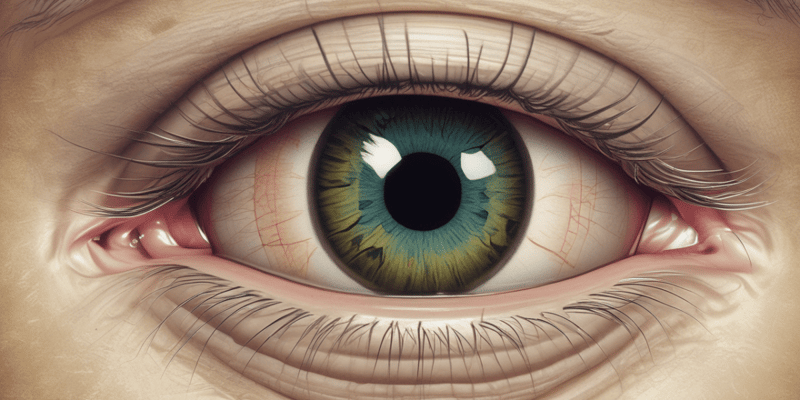Podcast
Questions and Answers
What is the projection of the nasal visual field onto the retina?
What is the projection of the nasal visual field onto the retina?
Where do the nerve fibers from the optic tract terminate?
Where do the nerve fibers from the optic tract terminate?
What is the result of the optical properties of the lens on the visual field?
What is the result of the optical properties of the lens on the visual field?
What is the function of the Pretectal Area in the midbrain?
What is the function of the Pretectal Area in the midbrain?
Signup and view all the answers
What is the correct sequence of the visual pathway?
What is the correct sequence of the visual pathway?
Signup and view all the answers
What is the projection of the upper visual field onto the retina?
What is the projection of the upper visual field onto the retina?
Signup and view all the answers
What is the result of the reflection of the coffee mug in Figure 9 into the retina?
What is the result of the reflection of the coffee mug in Figure 9 into the retina?
Signup and view all the answers
Which structure is affected in Lesion F?
Which structure is affected in Lesion F?
Signup and view all the answers
What is the explanation for the lower to upper reversal in Lesion F?
What is the explanation for the lower to upper reversal in Lesion F?
Signup and view all the answers
What is the characteristic feature of Lesion G?
What is the characteristic feature of Lesion G?
Signup and view all the answers
What is the possible reason for macular sparing in Lesion G?
What is the possible reason for macular sparing in Lesion G?
Signup and view all the answers
What is the direct response to light stimulation in the pupillary light reflex?
What is the direct response to light stimulation in the pupillary light reflex?
Signup and view all the answers
What is the response in the unstimulated eye during the pupillary light reflex?
What is the response in the unstimulated eye during the pupillary light reflex?
Signup and view all the answers
What is the term for the pathway that is interrupted in Lesion F?
What is the term for the pathway that is interrupted in Lesion F?
Signup and view all the answers
What is the primary function of the accommodation reflex?
What is the primary function of the accommodation reflex?
Signup and view all the answers
Which brain area is responsible for processing visual information in the accommodation reflex pathway?
Which brain area is responsible for processing visual information in the accommodation reflex pathway?
Signup and view all the answers
What is the name of the muscle responsible for constricting the pupils in the accommodation reflex?
What is the name of the muscle responsible for constricting the pupils in the accommodation reflex?
Signup and view all the answers
Which ganglion is responsible for transmitting impulses to the ciliary muscle to thicken the lens?
Which ganglion is responsible for transmitting impulses to the ciliary muscle to thicken the lens?
Signup and view all the answers
What is the main difference between the pupillary light reflex and the accommodation reflex in terms of their pathways?
What is the main difference between the pupillary light reflex and the accommodation reflex in terms of their pathways?
Signup and view all the answers
What is the role of the oculomotor nucleus in the accommodation reflex pathway?
What is the role of the oculomotor nucleus in the accommodation reflex pathway?
Signup and view all the answers
Which structure is responsible for relaying impulses from the superior colliculus to the Edinger-Westphal nucleus in the accommodation reflex pathway?
Which structure is responsible for relaying impulses from the superior colliculus to the Edinger-Westphal nucleus in the accommodation reflex pathway?
Signup and view all the answers
What is the primary function of the pupillary dilation reflex in low light intensity?
What is the primary function of the pupillary dilation reflex in low light intensity?
Signup and view all the answers
Which nerve is responsible for constricting the pupils?
Which nerve is responsible for constricting the pupils?
Signup and view all the answers
What is the result of an interruption in the pre-ganglionic fibers of the sympathetic area?
What is the result of an interruption in the pre-ganglionic fibers of the sympathetic area?
Signup and view all the answers
In which axes does the eye move with respect to the pupil?
In which axes does the eye move with respect to the pupil?
Signup and view all the answers
What is the primary function of the radial dilator pupillae?
What is the primary function of the radial dilator pupillae?
Signup and view all the answers
What is the term for the condition characterized by loss of pupillary dilation, constant ipsilateral constriction of the pupil, and anhidrosis?
What is the term for the condition characterized by loss of pupillary dilation, constant ipsilateral constriction of the pupil, and anhidrosis?
Signup and view all the answers
What is the term for the movement of the eyeball in three axes with respect to the pupil?
What is the term for the movement of the eyeball in three axes with respect to the pupil?
Signup and view all the answers
Which extraocular muscle is an abductor?
Which extraocular muscle is an abductor?
Signup and view all the answers
What is the action of the superior oblique muscle?
What is the action of the superior oblique muscle?
Signup and view all the answers
Which nerve innervates the superior rectus muscle?
Which nerve innervates the superior rectus muscle?
Signup and view all the answers
Which muscle has an extorsion action?
Which muscle has an extorsion action?
Signup and view all the answers
What is the function of the Levator palpebrae superioris?
What is the function of the Levator palpebrae superioris?
Signup and view all the answers
Which muscle is an elevator of the eye?
Which muscle is an elevator of the eye?
Signup and view all the answers
Which nerve innervates the lateral rectus muscle?
Which nerve innervates the lateral rectus muscle?
Signup and view all the answers
What is the action of the inferior rectus muscle?
What is the action of the inferior rectus muscle?
Signup and view all the answers
Which muscle is an intortor?
Which muscle is an intortor?
Signup and view all the answers
What is the abbreviation for the nerves that innervate the extraocular muscles?
What is the abbreviation for the nerves that innervate the extraocular muscles?
Signup and view all the answers
Study Notes
Binocular Visual Field and Retinal Projection
- The binocular visual field is divided into 4 quadrants: nasal and temporal halves, and superior and inferior halves.
- The visual field is projected to the retina in an inverted (upside down) and reversed (left to right) manner.
- Temporal visual field is projected to the nasal hemiretina, and nasal visual field is projected to the temporal hemiretina.
- Upper visual field is reflected to the lower hemiretina, and lower visual field is reflected to the upper hemiretina.
Overview of the Eye
- For vision to occur, reflective rays of light from an object strike the eye.
- The optic tract consists of nerve fibers that run directly without interruption posterior to the optic chiasm.
- The optic tract terminates in one of three locations: the lateral geniculate body, superior colliculi, or pretectal area.
Anatomy of Optic and Extraocular Motor Pathways
- Pupillary light reflex: both pupils constrict when light is directed to one eye due to the contraction of the sphincter pupillae muscle.
- Direct light reflex: direct response of the stimulated eye.
- Consensual/indirect reflex: response in the unstimulated eye.
Accommodation/Convergence Reflex
- Accommodation: to fixate on a nearby object.
- Converge: when eyes are directed to an object close to the face.
- Three reflex responses are brought about making up the accommodation reflex: miosis, lens thickening, and ocular convergence.
- The accommodation reflex pathway involves the primary visual cortex, secondary visual association area, optic radiation, superior colliculus, and pretectal area.
Comparison of Pupillary Light and Accommodation Reflexes
- Both pathways traverse the same structure until they reach the midbrain.
- In the midbrain, the pupillary light reflex reaches the pretectal nuclei, and the accommodation reflex reaches the superior colliculus.
- After reaching the midbrain, they follow the same structures, but the pupillary light reflex reaches the constrictor pupillae muscle, and the accommodation reflex reaches the muscle of iris and ciliary body (lens thickening).
Pupillary Dilation Reflex
- In low light intensity, the pupils dilate.
- The pupillary dilation reflex pathway involves the sympathetic area and radial dilator pupillae.
- Interruption anywhere in the pre and post ganglionic fibers of the sympathetic area result in the ipsilateral Horner's syndrome.
Neuroanatomical Basis of Extraocular Movement
- The eye moves in 3 axes with respect to the pupil: anteroposterior, vertical, and transverse.
- General actions of EOMs: all recti muscles are adductors, all oblique muscles are abductors, all superior muscles are intorters, and all inferior muscles are extorters.
- Action of muscles is not limited to one axis and depends on the angles of the insertion of the different EOMs.
- Innervation of EOMs: oculomotor nerve (CN III), trochlear nerve (CN IV), and abducens nerve (CN VI).
Studying That Suits You
Use AI to generate personalized quizzes and flashcards to suit your learning preferences.
Description
Test your understanding of binocular visual field, inversion and reversion of the retinal field, and how it is projected to the retina in an inverted and reversed manner. Learn about the nasal and temporal halves and superior and inferior halves of the visual field. Assess your knowledge of the optical properties of the lens.




